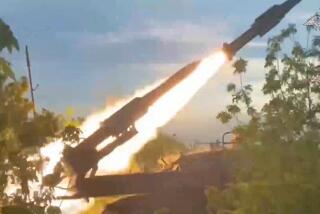At least 200 bodies from downed jet arrive in Ukraine-controlled city
A train carrying the bodies of at least 200 victims from Malaysia Airlines Flight 17 arrived in the government-controlled Ukrainian city of Kharkiv on Tuesday afternoon, bringing some relief to their families five days after the plane was downed.
Dutch specialists said they had recorded 200 bodies in their inspection of the train and would continue their work Wednesday. Volodymyr Groysman, the Ukrainian official in charge of the crash site, said the train held 282 bodies and 87 body parts. A total of 298 people were on board when the plane was shot down Thursday on a flight from Amsterdam to Kuala Lumpur, Malaysia.
On Wednesday, the first group of bodies will be flown on a Dutch military jet to the Netherlands, which lost 193 citizens on the flight, for forensic analysis. It was not yet clear when families would receive the remains.
U.S. intelligence agencies believe that pro-Russia separatists, with the possible support and training of Moscow, fired a missile at the plane over a contested part of eastern Ukraine. The insurgents finally released the bodies Monday but remain in control of the crash site.
On Tuesday, senior American intelligence officials said they believed the separatists fired on the jet by mistake, possibly misreading fuzzy radar images on a surface-to-air missile launcher provided by Russia. The launcher used a rudimentary radar system that was designed to be linked to another radar, which apparently was absent, that would have allowed the crew to distinguish between military and civilian aircraft, the officials said.
The missile, believed to be a heat-seeking SA-11, was probably fired by an “ill-trained crew,” said one U.S. official, who requested anonymity because he wasn’t authorized to speak publicly on the issue.
In Brussels, Europe’s top diplomats agreed Tuesday to a new round of sanctions on Russian officials and entities that are believed to have contributed to the unrest in eastern Ukraine, but they stopped short of sanctions against whole sectors of the Russian economy. They ordered bureaucrats with the European Union’s 28 member states to come up with such targeted measures by Thursday, which could be activated if Moscow persists in destabilizing Ukraine.
Those measures would curtail trade in arms, energy technology and goods with both military and civilian applications, and restrict Russian access to capital markets.
“The cronies of Mr. Putin and his clique in the Kremlin are the people who have to bear the pressure, because it is only them feeling the pressure that will in turn put pressure on the Russian government,” British Foreign Secretary Philip Hammond said, referring to Russian President Vladimir Putin. “If the financial interests of the group around the leadership are affected, the leadership will know about it.”
The U.S. intelligence officials suggested Tuesday that Russia has continued to arm the separatists, saying about 20 tanks and armored vehicles had crossed the border from Russia into eastern Ukraine since Thursday’s crash.
In Ukraine, the train carrying the remains made a halting journey to Kharkiv after leaving the separatist-controlled town of Torez on Monday evening, remaining in the separatist stronghold of Donetsk overnight as fighting raged near the station. The 180-mile journey took about 16 hours. Bodies had not been loaded on the train until Sunday after lying at the crash site in the summer heat for several days.
At the site, meanwhile, the separatists appeared to have cut into and carted off pieces of the plane.
Investigators from the Organization for Security and Cooperation in Europe on Tuesday corroborated anecdotal reports from townspeople, who had seen pieces of the aircraft carried away by forklift.
Investigators had expressed concern about tampering when the site was closed to investigators for several days after the crash. Those experts began to gain full access to the site Monday.
Dutch and Malaysian forensic experts are in eastern Ukraine to analyze the site. Investigators from the International Civil Aviation Organization are expected to arrive soon, as are officials with the U.S. National Transportation Safety Board. Typically, those groups collect as much of the plane as possible to attempt to reconstruct the accident. Their jobs will be difficult, however, if large portions are missing.
The leader of the separatists in the area, Alexander Boroday, has not said he will share with investigators any evidence found by his people.
To pressure Russia to cut ties with those separatists, several European nations made their case in Brussels on Tuesday.
Among those pressing for tougher action against Moscow are former Soviet bloc countries, including Baltic nations nervous about the ambitions of the giant neighbor that once held them in its orbit.
Lithuanian Foreign Minister Linas Linkevicius said before meeting his EU counterparts that Europe’s penchant for moving slowly and cautiously had exacerbated the situation.
“Sometimes by our inaction, by our ‘wait’ position, we are becoming part of the problem,” Linkevicius said.
Zeitchik reported from Kiev and Chu from London. Times staff writer Brian Bennett in Washington contributed to this report.
More to Read
Sign up for Essential California
The most important California stories and recommendations in your inbox every morning.
You may occasionally receive promotional content from the Los Angeles Times.












